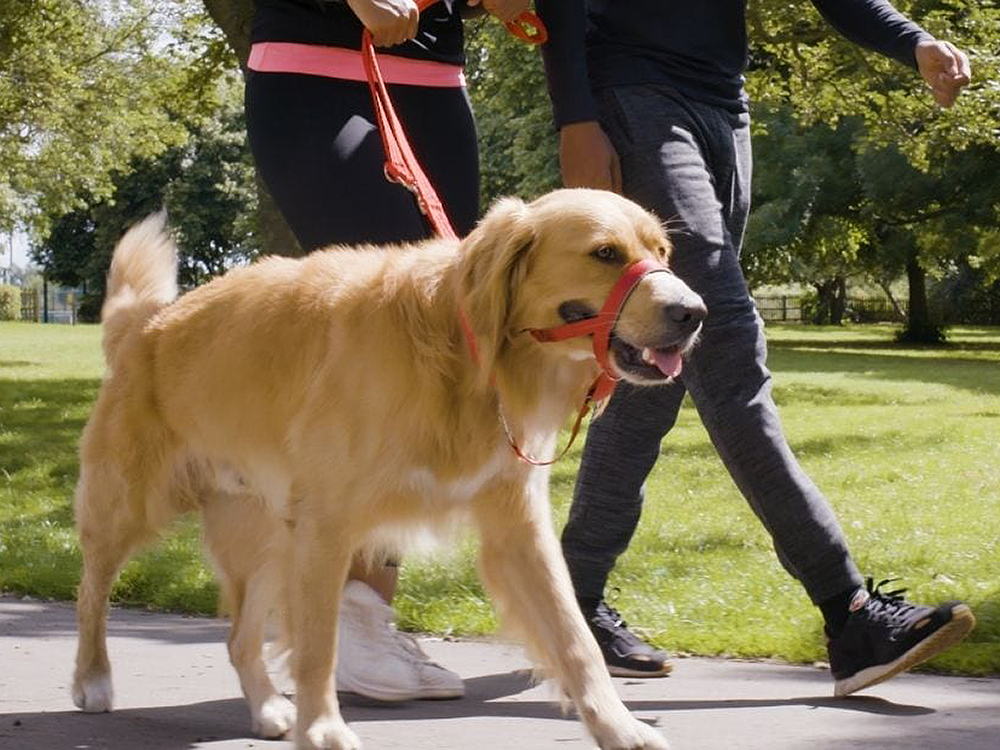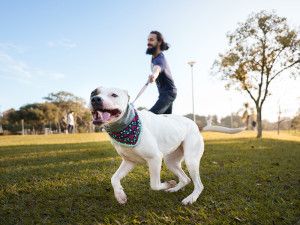Should You Hit Pause on Head Haltis?
Head haltis, aka gentle leads, are a very common tool in training, but here are some things to consider before using one.

share article
If you’re like me and have enjoyed the unique pleasure of attempting to walk a leash-reactive dog, you know how frustrating a process it can be. When a pup is prone to pulling, it can really take the joy out of a casual stroll for all involved. With that in mind, you’ve probably conducted a lot of personal research looking for solutions by way of Google. While exhaustingly browsing, there is one common option that no doubt popped up early and often — the head halti. Unfortunately, there is also a bit of confusion surrounding how best to use this tool and its potential repercussions. Some experts claim it is the key to a peaceful walk, while others warn it can create more problems when employed incorrectly.
The 411 on Head Haltis
Also known as a “gentle leader” or “head halter,” the head halti features a collar that wraps around the dog’s muzzle before looping around their neck and connecting to a leash. It’s a simple design that can seem much preferable to the other solutions you might find on Amazon.
“They are a popular choice because they usually look less aversive than prong collars and they are quick to help someone walk their hard-pulling dog,” says Charlie DiBono, trainer and founder of Body and Mind K9opens in a new tab in Long Beach, California. He fears that while these leashes can help cease pulling in the short term, over time this welcomed result will fade as the negative consequences remain and only intensify.
“As trainers, we try to help our clients feel confident walking their dogs. This tool allows people to feel that quickly, however, the risks are not worth the reward, especially with so many other options for tools with lower risks,” DiBono says, adding that he has never recommended the head halti to pet parents. “Personally, I feel that they are extremely dangerous and harmful to a dog,” he adds.
It’s a controversial take, given that the leash is widely used by many dog-training professionals to help battle pulling and reactivity. For instance, president and co-founder of Synergy Veterinary Behavior Dr. Valli Parthasarathyopens in a new tab believes that head halters can be extremely useful when used correctly. “I do think that they can be really effective. But we also have to be selective with, what patients we use them with and we certainly don’t use them for all patients,” she says. Dr. Parthasarathy adds that these leashes provide more physical control over dogs than a standard neck collar or harness. The key, however, is ensuring the dog is comfortable and conditioned to wearing the head halter properly.
Some Things to Keep in Mind About Head Haltis
Head haltis take much of their inspiration from that of a horse’s collar, and structurally they are nearly identical. DiBono believes therein lies the problem. “Dogs’ necks are not built like a horse’s and can easily be damaged by an owner pulling too hard in one direction,” he says. On top of being substantially smaller than horses, a dog’s neck is obviously shorter and far less muscular. So, if their neck is being pulled too hard in one direction, it could easily be injured. Beyond that, the muzzle is a much more sensitive region for dogs than horses.
DiBono explains that dogs have a massive amount of sensitive nerves running through their noses. As a result, they have nerve pathways close to the surface that can be delicate and easily impaired when too much pressure is put on the surrounding area. He fears that this can cause serious damage to a dog’s famously powerful sense of smell. This is a potential injury that would have wide-ranging implications, as dogs use their olfactory abilities to gather critical information about their environment, navigate their surroundings, and as a means of recognizing their people.
“Through these nerves that lead from their nose to their eyes, dogs can literally see things that they smell,” DiBono says. We should not be placing any pressure in such a sensitive location and applying force to their heads causing trauma to their neck.” He worries that beyond nerve and nose damage, neck and spine injuries are also risks involved with the force applied from a head halti.
If You Use a Head Halti, Take These Precautions
Dr. Parthasarathy clarifies that while there hasn’t been significant research into these potential damages, she has witnessed adverse reactions in dogs using head halters — albeit with less severe consequences. Generally, it results from pet parents not having properly introduced the tool and allowing pups to become comfortable with it.
“I have seen dogs that have will scratch the ground, rub their face on the ground, or scratch out their faces with their paws so that they really abrade the area or start bleeding,” she explains. Additionally, she notes that the risk of neck injury is fairly low. That being said, if a dog has a pre-existing neck injury, Dr. Parthasarathy would advise against the use of a gentle leader.
Now, none of this means you have to resign yourself to a life of sore wrists and blistered hands. There are safe and successful solutions to tempering leash reactivity with or without head halters. Dr. Parthasarathy says that above all, it’s imperative to afford pups the proper time and training to acclimate to these tools before taking them out for a stroll in public.
“We can minimize the chances of any sort of negative consequence of these leashes by doing training in situations where the dog can wear the halter and learn behaviors without external stimuli that might trigger them,” she says. Dr. Parthasarathy advises allowing dogs to smell the leash before giving them a treat to create a positive association. Then you can gradually work up to putting it on and walking around your home and eventually outside once they’re comfortable. Fit is equally crucial. Dr. Parthasarathy states that this tool should not be mistaken for a muzzle and not be too tight over the mouth. “The head halter is more of a seatbelt. It’s ideally not the primary way that we’re controlling the dog,” she explains.
Another Option to Try
If you want an alternative to head haltis altogether, DiBono recommends a well-fit slip. These leashes slide right over a dog’s head to rest comfortably on their neck. However, what is most effective is teaming with a trainer to help resolve any pulling or leash reactivity. Both Dr. Parthasarathy and DiBono agree that the safest means of attacking these problems is with a professional who can guide both you and your pet toward a more enjoyable walking situation. This will also minimize any user errors or possible injuries from misuse and hopefully end at a place where assistance is no longer necessary.
“Your biggest asset is a well-educated trainer. Ask them to show you how to properly fit, condition, use, and phase out tools. There should always be the goal of not using the tool anymore as they are just training aids,” DiBono says.

Sean Zucker
Sean Zucker is a writer whose work has been featured in Points In Case, The Daily Drunk, Posty, and WellWell. He has an adopted Pit Bull named Banshee whose work has been featured on the kitchen floor and whose behavioral issues rival his own.
Related articles
![Dog walker walking with her pet on leash on the sidewalk]() opens in a new tab
opens in a new tab10 Tips You’ll Definitely Want to Follow When You Walk Your Dog
From the safest gear to training recs.
![Woman walking her dog in a park]() opens in a new tab
opens in a new tabDog Walking 101: How Often You Should Walk Your Dog
Your dog may need more exercise than you think, according to two vets and a behaviorist.
![Barking dog on the leash outdoors. Russian spaniel at a walk misbehaving or being bad tempered]() opens in a new tab
opens in a new tabDoes Your Dog Act Diabolical on a Leash?
Same! Here’s how I got my pup to stop barking and lunging at everything that moves on walks.
![French bulldog smiling with blue harness]() opens in a new tab
opens in a new tabStrap in: Dog Collars vs. Harnesses
Style and safety don’t have to be mutually exclusive (phew).
![Woman with neck-length black hair wearing all black leather and black converse walking her brown dog on a black and white harness against a yellow tin background]() opens in a new tab
opens in a new tabThe Best Dog Harnesses of 2024
Experts pick the best harnesses for every kind of dog—from flat-faced breeds to tiny teacups to escape artists.
![A woman feeding her dog a treat while on a hike.]() opens in a new tab
opens in a new tabWhy Your Dog Needs a Martingale Collar
For starters, it prevents escape, works as a training tool, and is recommended by rescue workers.









